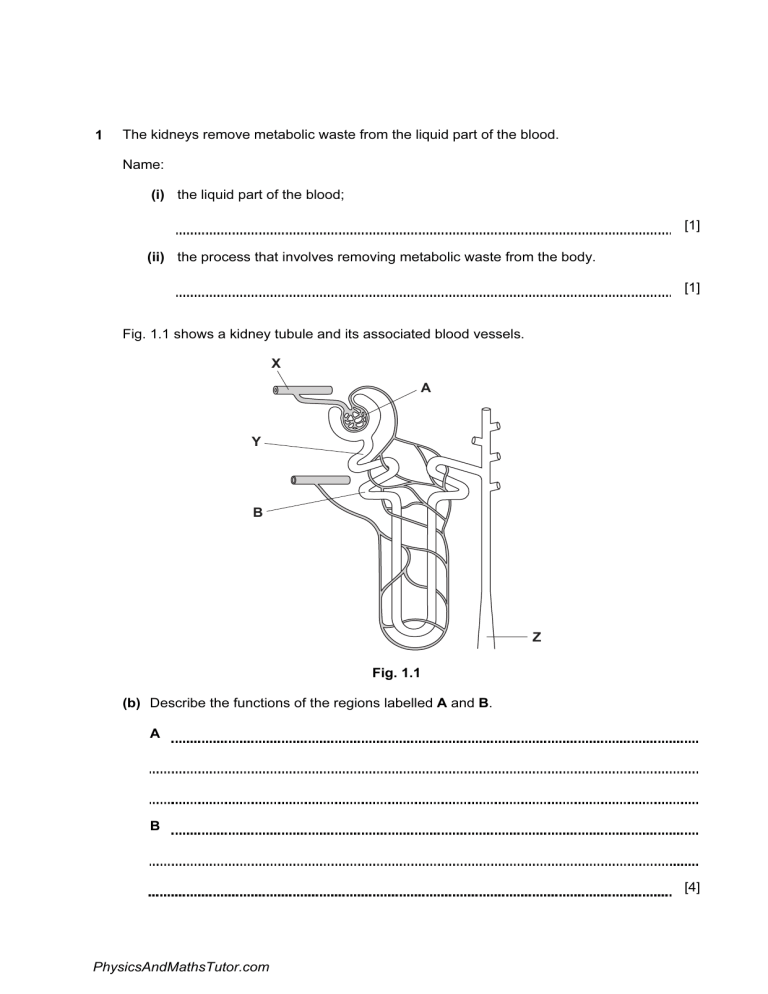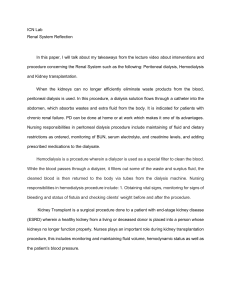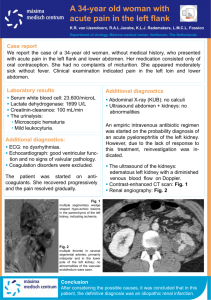
1 The kidneys remove metabolic waste from the liquid part of the blood. Name: (i) the liquid part of the blood; [1] (ii) the process that involves removing metabolic waste from the body. [1] Fig. 1.1 shows a kidney tubule and its associated blood vessels. X A Y B Z Fig. 1.1 (b) Describe the functions of the regions labelled A and B. A B [4] PhysicsAndMathsTutor.com Table 1.1 shows the concentrations of some substances in the blood at X, the fluid at Y and the urine at Z. Table 1.1 (c) Name the substance shown in Table 1.1 that: (i) has molecules that are too large to pass through the walls of capillaries; [1] (ii) is all reabsorbed in the kidney; [1] (iii) is a metabolic waste product. [1] (d) Explain why the concentrations of sodium ions and urea are greater at Z than at Y. [2] PhysicsAndMathsTutor.com (e) People who have acute kidney failure are given dialysis treatment. In dialysis machines, the blood flows through narrow tubes made from partially permeable membranes, surrounded by dialysis fluid. (i) Dialysis fluid contains sodium ions. Use the information in Table 1.1 to suggest the concentration of sodium ions that should be in the fluid and give a reason for your answer. concentration g per 100 cm3 reason [2] (ii) State two components of blood that are not in dialysis fluid. 1 2 [2] (f) Heparin is added to the blood before it returns to the body from the dialysis machine. Heparin prevents a person’s blood from clotting. Describe the process of blood clotting. [3] [Total: 18] PhysicsAndMathsTutor.com 2 Fig. 3.1 shows a vertical section of a kidney. E F G Fig. 3.1 (a) Name the parts E, F and G. E F G PhysicsAndMathsTutor.com [3] (b) Substances move into and out of cells in kidney tubules. Fig. 3.2 shows four processes, H, J, K and L, that occur in cells lining the kidney tubule. The net movement of substance is shown by an arrow, in each case. H J K L nucleus kidney tubule cell outside the cells key high concentration low concentration Fig. 3.2 (i) Complete Table 3.1 by stating the letter, H, J, K or L, which identifies each of the processes. Give a reason for each answer. Table 3.1 process rocess reason diffusion of oxygen active uptake of sodium ions [4] PhysicsAndMathsTutor.com (ii) Glucose is filtered from the blood. Usually all of it is reabsorbed by the kidney tubules so that there is none present in the urine. Name the part of the kidney where filtration occurs. [1] (iii) Use Fig. 3.2 to describe how kidney tubules reabsorb glucose from the filtrate. [2] (c) When plants are grown in a solution that includes a poison that prevents respiration, the roots continue to absorb water, but do not absorb many ions. Explain this result. [3] [Total: 13] PhysicsAndMathsTutor.com 3 (a Define the term excretion. [3] Fig. 2.1 shows a kidney tubule and the blood vessels associated with it. A H B C G D E F Fig. 2.1 PhysicsAndMathsTutor.com (b) Table 2.1 shows some processes that occur in a kidney. In Table 2.1, write the letter of the part shown in Fig. 2.1 where each process occurs. You must put one letter in each box. You may use the same letter more than once. Table 2.1 letter process filtration of blood reabsorption of most of the solutes from the filtrate water is absorbed by osmosis to determine the concentration of urine unfiltered blood returns to the renal vein [4] (c) Table 2.2 lists the components of blood, filtrate and urine. Table 2.2 component ompon red blood cells white blood cells plasma proteins glucose urea salts water filtrate urine Complete the table by using ticks () and crosses () to show whether or not each component is present in filtrate and in urine of a healthy person. The first component has been done for you. [2] [Total: 9] PhysicsAndMathsTutor.com 4 A healthy kidney controls the excretion of urea and other waste products of metabolism from the blood. After kidney failure there are two possible treatments: dialysis or a kidney transplant. Fig. 4.1 shows how blood and dialysis fluid move through a dialysis machine. A blood flow dialysis fluid B bubble trap pump blood patient’s arm Fig. 4.1 (a) Describe the changes that occur to the blood as it flows through the dialysis machine from A to B. [2] PhysicsAndMathsTutor.com (b) Discuss the advantages of kidney transplants compared with dialysis. [3] PhysicsAndMathsTutor.com (c) Two brothers have to make a difficult decision. One brother, with blood group AB, has kidney failure and is on dialysis. The healthy brother has agreed to donate one of his kidneys to his brother. He has to have a blood test. Their father has blood group A and their mother has blood group B. The brothers have a sister who has blood group O. (i) Explain how this girl has blood group O when her parents have different blood groups. You must use the space below for a genetic diagram to help your answer. Use the symbols IA, IB and IO to represent the alleles involved in the inheritance of blood groups. parental phenotypes blood group A × blood group B parental genotypes ................... × ................... ................... ................... + ................... ................... gametes girl’s genotype ................... girl’s phenotype ................... [4] (ii) The healthy brother can only donate the kidney to his brother if they both have the same blood group. What is the probability that the healthy brother also has blood group AB? [1] [Total: 10] PhysicsAndMathsTutor.com




